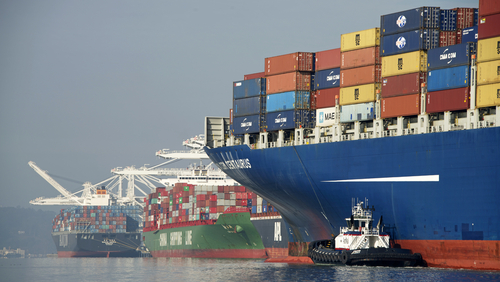About half of all U.S. cargo has flowed through the country's West Coast ports, including imports as diverse as sneakers, soy sauce and auto parts, most manufactured in Asia. But over the past year, supply-chain managers have increasingly shifted cargo to ports on the East Coast, Gulf Coast and in Western Mexico and Canada in attempts to avoid growing congestion resulting from labor talks between the International Longshore and Warehouse Union and the Pacific Maritime Association.
That trend has accelerated over the past several months, as ships lined up along the West Coast and port operations ground to a halt, according to shippers, supply-chain experts and port officials on both coasts.
This is bad news for West Coast ports, truckers and railroads already worried that the expansion of the Panama Canal, due for completion next year, would begin to divert more business to the East Coast. Already it is expected to take three to six months for West Coast ports to return to normal, while 29 ships were still anchored outside the ports of Los Angeles and Long Beach on Wednesday.
"About a third of our cargo is purely discretionary," meaning it can be shifted to other ports, said Gene Seroka, executive director of the Port of Los Angeles. "Some of that cargo has moved to other port complexes. It's going to be extremely difficult to earn that business back." The port couldn't provide an estimate on diverted cargo, but imports fell 28% year-over-year in January.
Supply-chain flexibility has become increasingly important since the 2008 economic crash, as businesses have become more focused on keeping inventories lean and scheduling deliveries to arrive just as they are needed. Decisions are made on a day-to-day basis, with the most sophisticated shippers tracking progress of their shipments via cloud-based technology.
The West Coast port chaos is just the latest event triggering shippers to both diversify transportation modes and ports. Hurricanes, a winter involving polar-vortex weather, or labor issues all can trigger severe product delays or even empty shelves, costing companies tens of millions of dollars.
The biggest shippers, including Wal-Mart Stores Inc., Home Depot Inc. and Target Corp. , have employed for years what is known in the industry as a four-corner strategy, in which networks are expanded to include warehouses at northern and southern ports on both coasts and the Gulf of Mexico. Now even smaller companies are diversifying.
A survey of 138 shippers last week by the Journal of Commerce showed that 65% said they planned to ship less cargo through the U.S. West Coast through 2016, with a similar percentage planning to permanently reroute some cargo.
The leasing of industrial real estate rose along the East Coast last year, including in Savannah, Ga., where vacancy rates fell to 5% in the fourth quarter, compared with 9% in 2013, according to Colliers International-Savannah LLC. West Coast ports' volume growth ground to a halt, while East Coast ports reported gains. For example, volume fell 32% at the Port of Oakland in January, compared with a 15% gain at the Port of Virginia. Ocean carriers also experienced increased demand for space on ships bound for the East Coast, said a spokesman for Maersk Line, a unit of A.P. Møller Maersk A/S of Denmark.
Toy maker Hasbro Inc. switched its cargo to the East Coast over the past several months, shipping most containers of Transformers, My Little Pony and other toys via the Panama Canal to the Port of Savannah, instead of splitting cargo between the two coasts. Until the backlog is cleared, Hasbro said it will continue to do so, but the company declined to outline longer-term plans.
The longer route adds time and cost: It is roughly double the typical 14 days to Los Angeles from Asia. Still, Hasbro's profit margins rose last year, as the company squeezed out expenses elsewhere and learned to manage the longer route more smoothly. "The more we do it, the better we get at it," Hasbro Chief Executive Brian Goldner said in an interview.
Target has been using its massive network to reroute inventory, expedite shipments and preorder goods to avoid product shortages. After the backlog is cleared, the retailer will assess whether any permanent changes should be made. "When we get through it, we'll look at what worked," said Target's chief financial officer, John Mulligan . "There will be some learnings that come out of that."
Not every shipper will be able to diversify. Geography dictates which ports farmers must use for their exports, for instance. Small businesses will be crimped by cost. And many will simply choose not to.
"Currently, the lowest-cost option is to go to the West Coast ports," said Yossi Sheffi, director of the MIT Center for Transportation & Logistics, at the Massachusetts Institute of Technology. "The supply-chain procurement managers are doing this on day-to-day price cost pressures. Why rock the boat?"













 The labor dispute that caused months of gridlock at West Coast ports may be over, but the disruption is expected to redraw the trade routes goods follow as they journey to U.S. factories and store shelves. (See related
The labor dispute that caused months of gridlock at West Coast ports may be over, but the disruption is expected to redraw the trade routes goods follow as they journey to U.S. factories and store shelves. (See related